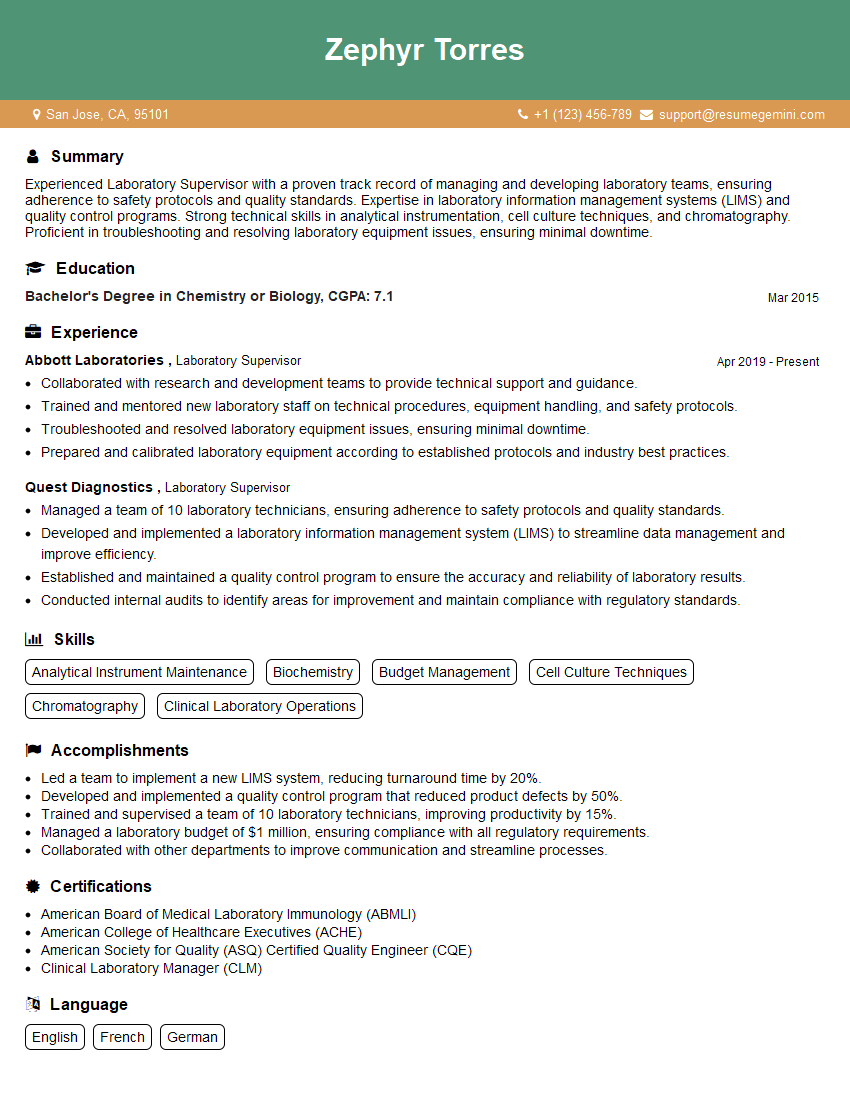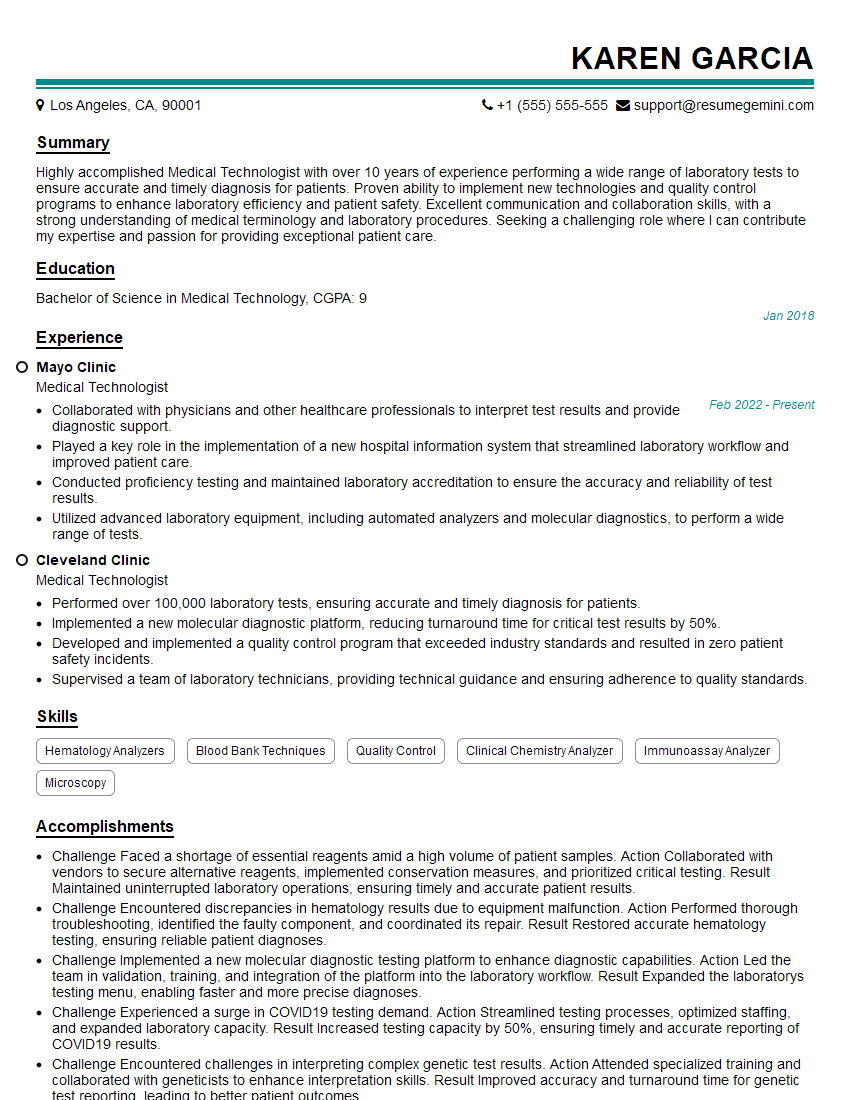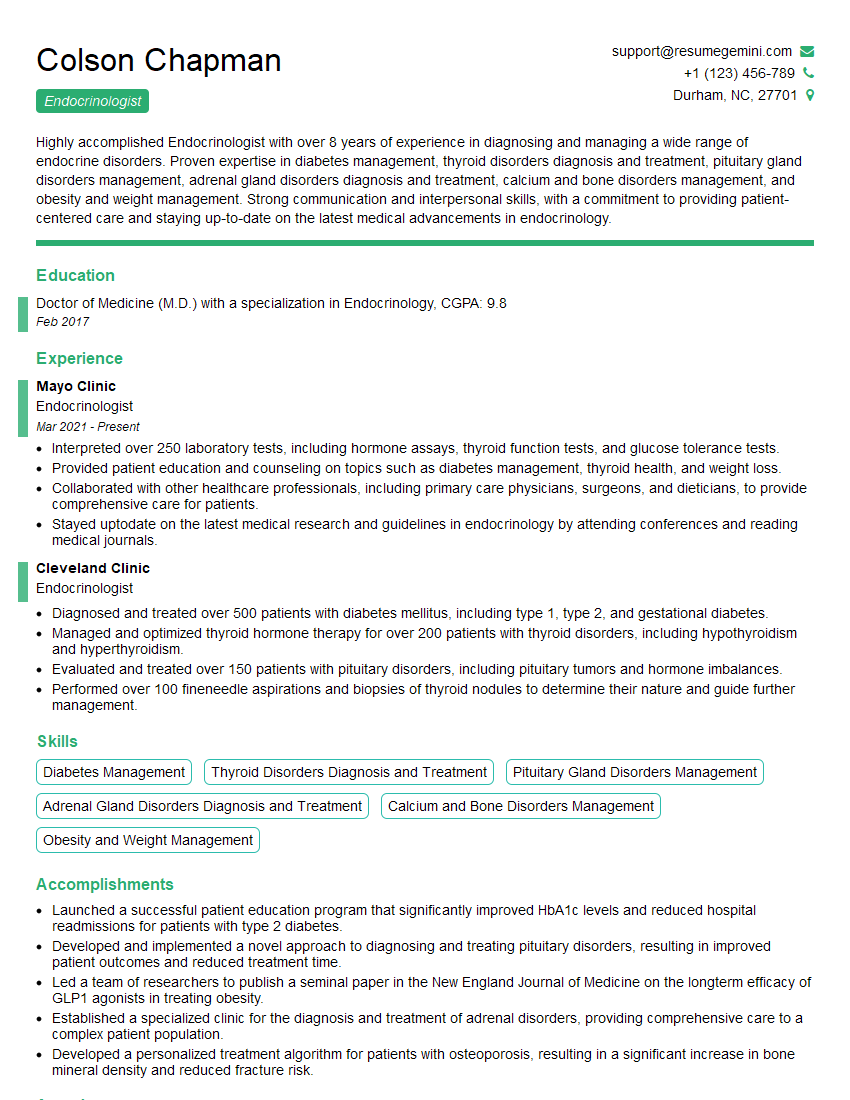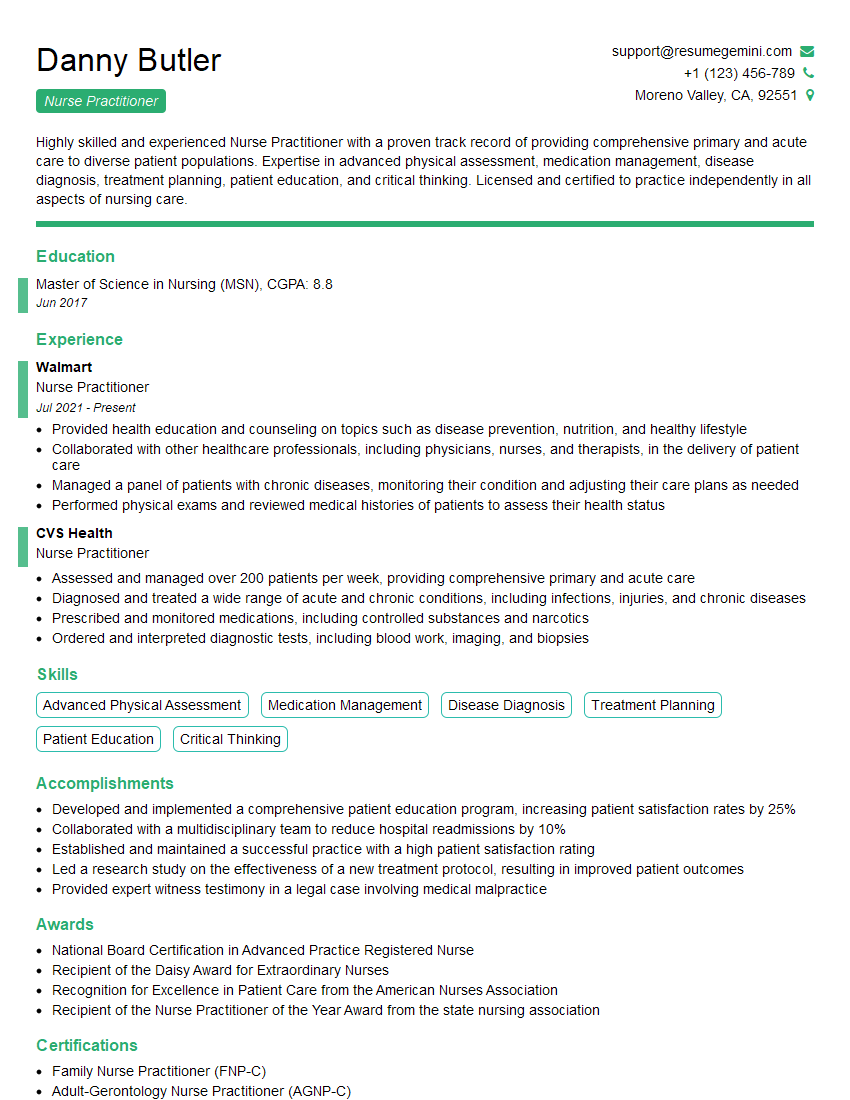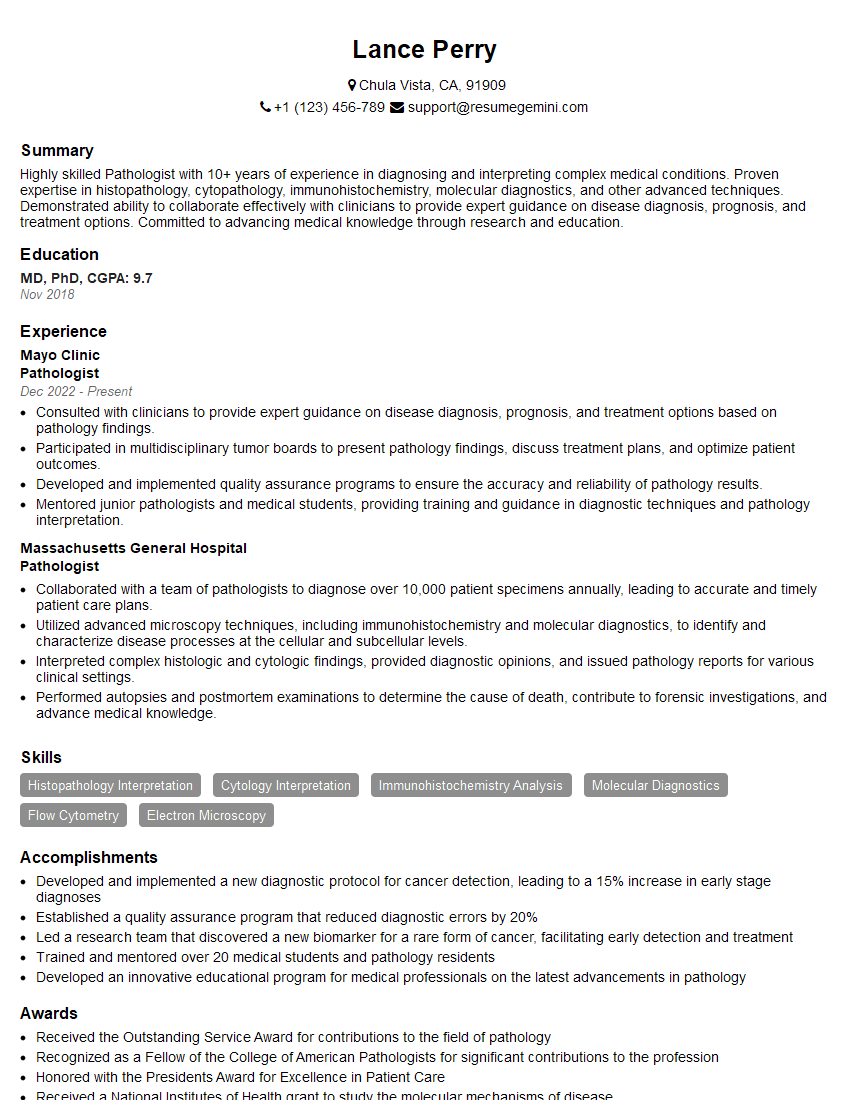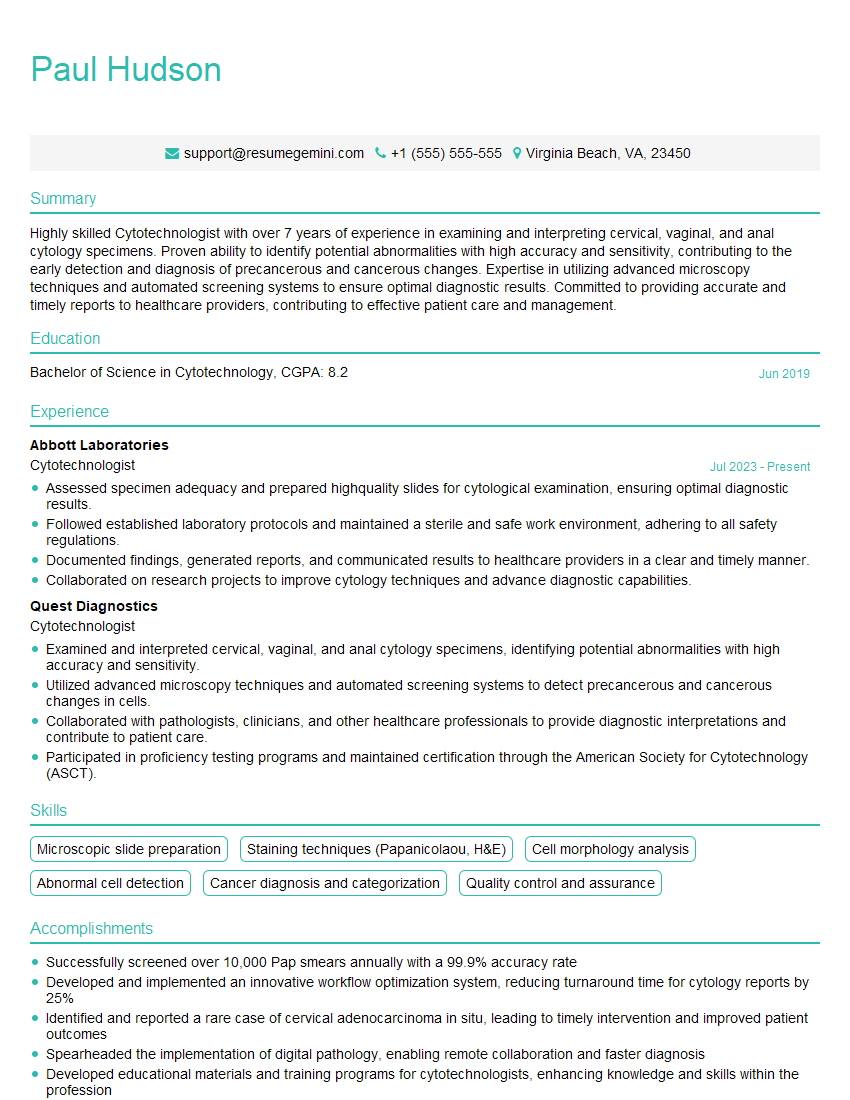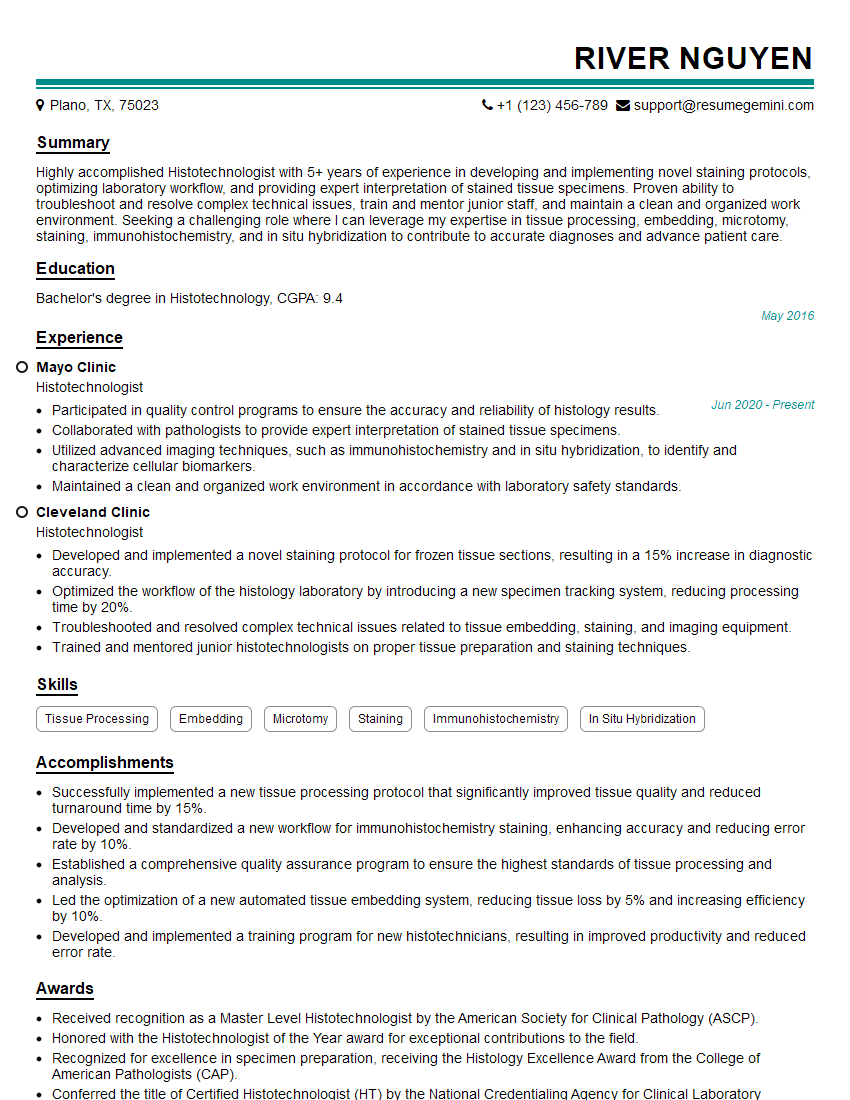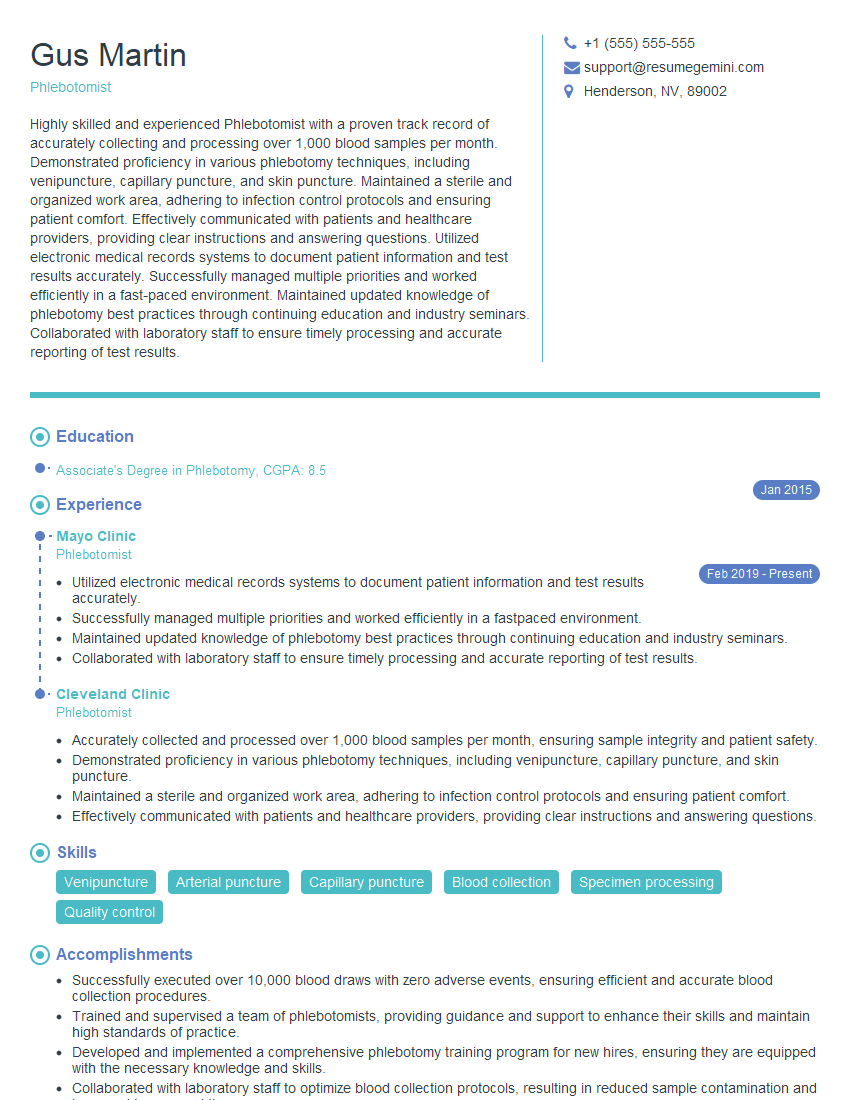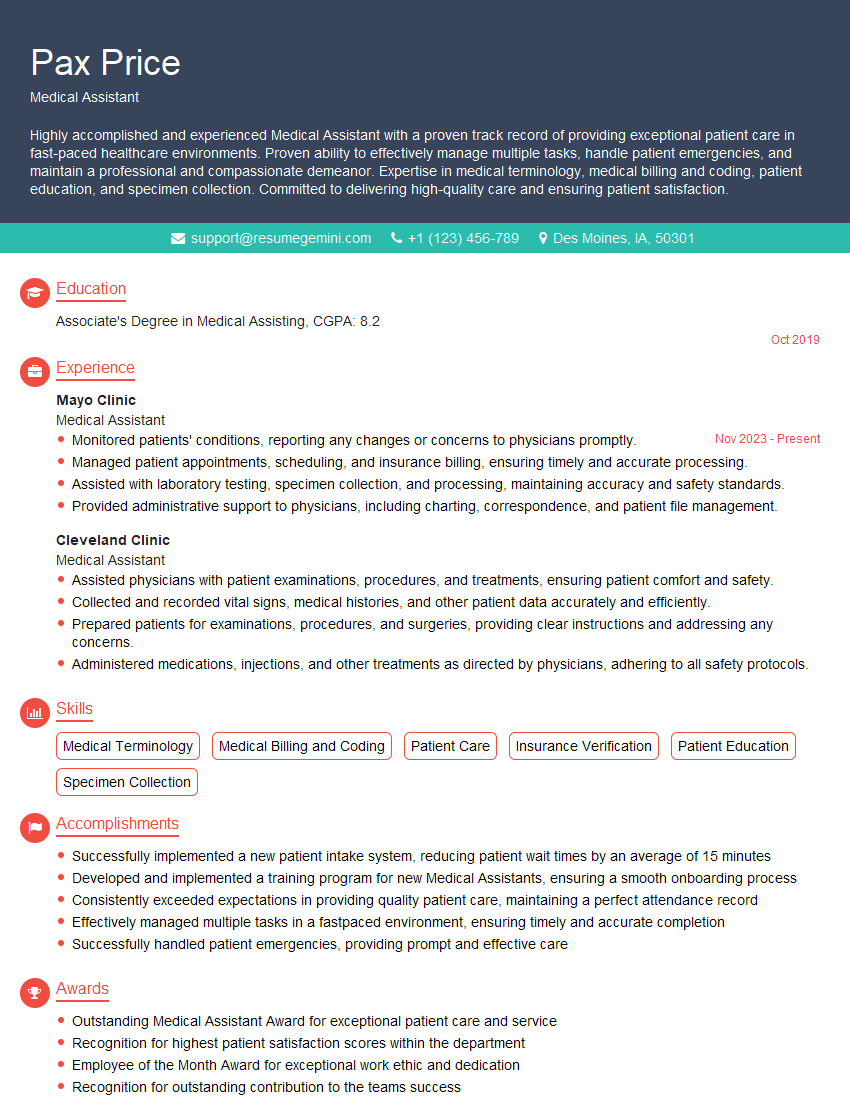Interviews are more than just a Q&A session—they’re a chance to prove your worth. This blog dives into essential Thyroid Function Testing interview questions and expert tips to help you align your answers with what hiring managers are looking for. Start preparing to shine!
Questions Asked in Thyroid Function Testing Interview
Q 1. What are the key hormones involved in thyroid function?
The thyroid gland produces several crucial hormones, but the primary ones involved in thyroid function testing are Thyroxine (T4) and Triiodothyronine (T3). These are the active thyroid hormones that regulate metabolism. Additionally, Thyroid Stimulating Hormone (TSH), produced by the pituitary gland, plays a vital role in controlling the production of T3 and T4.
Q 2. Explain the role of TSH, T3, and T4 in thyroid function.
Think of the thyroid-pituitary axis as a delicate feedback loop. The pituitary gland’s TSH acts like a conductor, instructing the thyroid orchestra (thyroid gland) to produce T3 and T4. T4 (Thyroxine) is the primary hormone produced by the thyroid, acting as a precursor to the more active T3 (Triiodothyronine). T3 is the primary hormone responsible for regulating metabolic processes throughout the body. When T3 and T4 levels are sufficient, they signal the pituitary gland to reduce TSH production. Conversely, low T3 and T4 levels trigger the pituitary to increase TSH production, trying to stimulate the thyroid to produce more hormones. This feedback mechanism ensures hormone levels stay within a healthy range.
Q 3. Describe the different types of thyroid disorders.
Thyroid disorders can broadly be categorized as hypothyroidism (underactive thyroid) and hyperthyroidism (overactive thyroid). Hypothyroidism occurs when the thyroid gland doesn’t produce enough T3 and T4. Hyperthyroidism happens when the thyroid gland produces excessive amounts of these hormones. There are also conditions like thyroid nodules (lumps in the thyroid), thyroiditis (inflammation of the thyroid), and thyroid cancer, each requiring specific diagnostic approaches. Finally, congenital hypothyroidism, present at birth, is a critical condition that needs immediate attention.
Q 4. What are the common symptoms of hypothyroidism and hyperthyroidism?
The symptoms of hypothyroidism and hyperthyroidism are often opposite, reflecting the contrasting effects of low versus high thyroid hormone levels. Hypothyroidism often presents with fatigue, weight gain, constipation, cold intolerance, dry skin, and depression. Imagine feeling constantly sluggish and cold – that’s a common picture. In contrast, hyperthyroidism often causes weight loss, nervousness, irritability, heat intolerance, increased sweating, and rapid heartbeat. Think of someone constantly feeling restless and hot – that’s characteristic of hyperthyroidism. It’s crucial to remember that the severity of symptoms can vary greatly among individuals.
Q 5. How do you interpret a patient’s thyroid function test results?
Interpreting thyroid function test results involves considering TSH, T3, and T4 levels together. A high TSH level usually indicates hypothyroidism, as the pituitary is trying to compensate for low T3 and T4. Low TSH usually suggests hyperthyroidism. However, T3 and T4 levels need to be assessed for confirmation. For example, a patient with a high TSH and low T3 and T4 has clear hypothyroidism. Conversely, a low TSH with high T3 and T4 indicates hyperthyroidism. The interpretation also depends on the patient’s clinical presentation, age, and medical history. It’s not simply about numbers; it’s about the clinical picture the numbers paint.
Q 6. What are the limitations of using only TSH to assess thyroid function?
While TSH is a valuable initial screening test for thyroid disorders, relying solely on it has limitations. Some conditions, like secondary or tertiary hypothyroidism (problems with the pituitary or hypothalamus), can cause low TSH levels despite underlying thyroid dysfunction. Also, TSH levels may be normal in some patients with mild hypothyroidism or early-stage hyperthyroidism. Therefore, measuring free T3 and free T4 is often necessary for a complete assessment. Think of it like this: TSH is a good indicator of thyroid function in many cases, but doesn’t provide the complete picture.
Q 7. Explain the significance of free T3 and free T4 levels.
Free T3 and free T4 represent the biologically active forms of these hormones – the fractions not bound to proteins in the blood. These are the hormones that are actually influencing metabolism. Measuring free T3 and free T4 levels provides a more accurate assessment of thyroid hormone activity compared to measuring total T3 and T4, which can be affected by changes in protein binding. For example, in some conditions, total hormone levels might be normal, but free levels are abnormal and causing symptoms. These are more reliable indicators of the hormonal state, offering a more precise picture of the situation.
Q 8. What are the factors that can affect thyroid function test results?
Several factors can influence thyroid function test results, leading to inaccurate interpretations if not considered. These factors can be broadly categorized into patient-related factors and laboratory-related factors.
- Patient-related factors: These include the patient’s age, gender, medications (e.g., amiodarone, lithium, and some antidepressants), pregnancy, recent illness, stress levels, and even the time of day the blood is drawn. For instance, TSH levels can naturally fluctuate throughout the day.
- Laboratory-related factors: Variations in assay methodologies between labs, the quality of reagents used, and even the handling and storage of the blood sample can affect the results. Different laboratories may have slightly different reference ranges.
Example: A patient taking lithium for bipolar disorder might have falsely elevated TSH levels, mimicking hypothyroidism, even if their thyroid is functioning normally. It’s crucial to consider the patient’s medication history when interpreting thyroid function tests.
Q 9. How do you differentiate between primary, secondary, and tertiary hypothyroidism?
Differentiating between primary, secondary, and tertiary hypothyroidism involves understanding where the problem originates within the hypothalamic-pituitary-thyroid (HPT) axis.
- Primary hypothyroidism: This is the most common type, where the thyroid gland itself is malfunctioning and failing to produce adequate thyroid hormone (T3 and T4). In primary hypothyroidism, TSH levels are elevated because the pituitary gland is trying to compensate for the thyroid’s inadequacy, while T3 and T4 are low.
- Secondary hypothyroidism: This occurs due to a problem in the pituitary gland, which fails to produce sufficient thyroid-stimulating hormone (TSH). Consequently, both TSH and thyroid hormones (T3 and T4) are low. The pituitary isn’t sending the signal to the thyroid.
- Tertiary hypothyroidism: This is the rarest form and results from a dysfunction in the hypothalamus, which fails to produce thyrotropin-releasing hormone (TRH). This leads to low levels of both TSH and thyroid hormones, similar to secondary hypothyroidism, but the root cause lies in the hypothalamus.
In summary: Consider this analogy: Imagine the hypothalamus as the CEO, the pituitary as the manager, and the thyroid as the worker. Primary hypothyroidism is a problem with the worker; secondary is a management issue, and tertiary is a problem with the CEO.
Q 10. Describe the appropriate follow-up testing for abnormal thyroid function test results.
Follow-up testing for abnormal thyroid function test results depends on the initial findings and the clinical picture. A thorough history and physical exam are always essential.
- Abnormal TSH: If TSH is significantly elevated or suppressed, further investigations may include repeat TSH and free T4 testing to confirm the initial findings. Thyroid antibodies (anti-TPO, anti-Tg) are frequently measured to assess for autoimmune thyroiditis (Hashimoto’s or Graves’).
- Suspected hypothyroidism: If hypothyroidism is suspected, further tests might involve thyroid ultrasound to visualize the thyroid gland’s structure and rule out nodules or other abnormalities. A thyroid scan may be necessary in certain cases.
- Suspected hyperthyroidism: If hyperthyroidism is suspected, thyroid uptake scan and/or thyroid antibody testing are critical to determining the underlying cause (e.g., Graves’ disease, toxic multinodular goiter).
Example: A patient with an elevated TSH and low free T4 should undergo thyroid antibody testing to look for autoimmune thyroid disease. A subsequent ultrasound could then evaluate the size and structure of the thyroid gland.
Q 11. What are the common causes of elevated TSH levels?
Elevated TSH levels primarily indicate hypothyroidism, where the thyroid gland doesn’t produce enough thyroid hormone. However, several factors can lead to elevated TSH:
- Primary hypothyroidism: This is the most frequent cause, resulting from conditions such as Hashimoto’s thyroiditis, autoimmune thyroid disease, thyroid surgery, or radiation therapy.
- Subclinical hypothyroidism: In this condition, TSH is elevated, but free T4 levels remain within the reference range. The clinical significance of subclinical hypothyroidism is still debated.
- Pituitary or hypothalamic disorders: While less common, problems in the pituitary (secondary hypothyroidism) or hypothalamus (tertiary hypothyroidism) can indirectly cause elevated TSH.
- Medications: Certain drugs like lithium and amiodarone can interfere with thyroid hormone production and lead to elevated TSH.
- Non-thyroidal illness: Severe illness or stress can temporarily suppress thyroid function, leading to a transient elevation in TSH.
Example: A patient presenting with fatigue, weight gain, and constipation might have elevated TSH due to underlying Hashimoto’s thyroiditis.
Q 12. What are the common causes of suppressed TSH levels?
Suppressed TSH levels, meaning lower than the reference range, usually indicate hyperthyroidism, a condition where the thyroid gland produces excessive thyroid hormone. Several factors can lead to this suppression:
- Graves’ disease: This autoimmune disorder is a frequent cause of hyperthyroidism, characterized by the production of thyroid-stimulating immunoglobulins (TSI).
- Toxic multinodular goiter: This involves multiple nodules within the thyroid gland autonomously producing thyroid hormones.
- Toxic adenoma: A single nodule within the thyroid can also produce excess hormones.
- Thyroiditis: In some forms of thyroiditis, such as subacute thyroiditis, a transient release of stored thyroid hormone can lead to suppressed TSH.
- Exogenous thyroid hormone intake: Taking excessive amounts of thyroid hormone medication can also cause TSH suppression.
Example: A patient with symptoms of nervousness, weight loss, and palpitations might have a suppressed TSH due to Graves’ disease.
Q 13. How do you interpret thyroid function tests in pregnant women?
Interpreting thyroid function tests in pregnant women requires careful consideration, as physiological changes during pregnancy affect thyroid hormone levels. TSH levels are typically lower in pregnancy due to increased production of human chorionic gonadotropin (hCG), which has weak TSH-like activity. Free T4 levels generally remain normal.
Reference ranges: It’s crucial to use pregnancy-specific reference ranges for interpreting thyroid function tests. A TSH level that might be considered normal in a non-pregnant woman may indicate hypothyroidism in a pregnant woman.
Gestational hypothyroidism: Untreated hypothyroidism during pregnancy can have adverse effects on fetal development. Early detection and management are crucial. Screening for hypothyroidism in early pregnancy is therefore recommended.
Postpartum Thyroiditis: It’s important to also monitor for postpartum thyroiditis, which can manifest as either transient hypothyroidism or hyperthyroidism in the months following delivery. Regular monitoring is crucial after pregnancy.
Q 14. How do you manage patients with subclinical hypothyroidism?
Managing subclinical hypothyroidism, characterized by elevated TSH but normal free T4 levels, is a matter of ongoing debate among endocrinologists. There’s no universally agreed-upon approach. Factors influencing management decisions include the patient’s age, symptoms, and the degree of TSH elevation.
Observation: Many experts recommend a watchful waiting approach, with regular monitoring of TSH and free T4 levels. If the patient is asymptomatic and TSH elevation is mild, treatment may not be necessary.
Treatment: If the patient experiences symptoms suggestive of hypothyroidism (fatigue, weight gain, constipation, etc.), or if TSH levels are significantly elevated, treatment with levothyroxine may be considered. Treatment decisions should be individualized, and close monitoring of TSH and free T4 levels during treatment is essential to ensure optimal dosage.
Example: A 40-year-old asymptomatic woman with a mildly elevated TSH but normal free T4 might be monitored closely without immediate treatment, while a 60-year-old woman with elevated TSH and symptoms of fatigue and depression would likely be started on levothyroxine.
Q 15. Discuss the role of thyroid antibodies in thyroid disease.
Thyroid antibodies are proteins produced by the immune system that mistakenly attack the thyroid gland. Their presence in the blood is a key indicator of autoimmune thyroid diseases. These antibodies don’t directly cause thyroid dysfunction, but their activity reflects the body’s immune response targeting the thyroid. There are several types, with Thyroid Peroxidase Antibodies (TPOAb) and Thyroglobulin Antibodies (TgAb) being the most commonly tested. High levels of these antibodies suggest an autoimmune process is at play, pointing towards conditions like Hashimoto’s thyroiditis (where the antibodies damage the thyroid, leading to hypothyroidism) or, less commonly, Graves’ disease (where the antibodies stimulate the thyroid, leading to hyperthyroidism). Detecting these antibodies helps diagnose and monitor the progression of autoimmune thyroid diseases.
For example, a patient presenting with fatigue, weight gain, and constipation might have elevated TPOAb levels, supporting a diagnosis of Hashimoto’s thyroiditis. Regular monitoring of antibody levels can help assess disease activity and treatment response. A decrease in antibody levels often correlates with improved thyroid function and overall well-being.
Career Expert Tips:
- Ace those interviews! Prepare effectively by reviewing the Top 50 Most Common Interview Questions on ResumeGemini.
- Navigate your job search with confidence! Explore a wide range of Career Tips on ResumeGemini. Learn about common challenges and recommendations to overcome them.
- Craft the perfect resume! Master the Art of Resume Writing with ResumeGemini’s guide. Showcase your unique qualifications and achievements effectively.
- Don’t miss out on holiday savings! Build your dream resume with ResumeGemini’s ATS optimized templates.
Q 16. Explain the difference between Hashimoto’s thyroiditis and Graves’ disease.
Hashimoto’s thyroiditis and Graves’ disease are both autoimmune thyroid disorders, but they have opposite effects on thyroid function. Hashimoto’s is an autoimmune disorder where the body’s immune system attacks and destroys thyroid tissue, leading to hypothyroidism (underactive thyroid). Think of it like a slow, destructive process where the thyroid gland gradually shrinks and produces less thyroid hormone. In contrast, Graves’ disease is also an autoimmune disorder, but in this case, the immune system produces antibodies that stimulate the thyroid gland, causing it to produce excess thyroid hormone, leading to hyperthyroidism (overactive thyroid). This is like a runaway process where the thyroid gland is constantly overstimulated and produces too much hormone.
Clinically, Hashimoto’s often presents with symptoms of hypothyroidism such as fatigue, weight gain, constipation, cold intolerance, and dry skin. Graves’ disease, on the other hand, frequently presents with symptoms of hyperthyroidism such as weight loss, nervousness, increased heart rate, heat intolerance, and tremor. Diagnosis typically involves blood tests measuring thyroid hormone levels (TSH, T3, T4) and thyroid antibodies (TPOAb, TgAb).
Q 17. What are the treatment options for hypothyroidism and hyperthyroidism?
Treatment for hypothyroidism and hyperthyroidism differs significantly because they represent opposite ends of the thyroid function spectrum. For hypothyroidism, the mainstay of treatment is thyroid hormone replacement therapy. This involves taking synthetic levothyroxine (T4) daily to replace the missing thyroid hormone. The dose is carefully adjusted based on individual needs and monitored through regular blood tests. For hyperthyroidism, treatment options depend on the severity and cause. They include antithyroid medications (like methimazole or propylthiouracil) to block thyroid hormone production, radioactive iodine therapy to destroy overactive thyroid tissue, or, in some cases, surgery to remove part or all of the thyroid gland. Beta-blockers may also be used to alleviate some of the symptoms like palpitations and tremor.
Choosing the right treatment approach for hyperthyroidism involves considering factors such as the patient’s age, overall health, and the severity of their hyperthyroidism. For instance, radioactive iodine therapy is often the preferred treatment for older patients, while antithyroid drugs might be the first choice for younger individuals, especially those planning to have children.
Q 18. How do you monitor the effectiveness of thyroid hormone replacement therapy?
Monitoring the effectiveness of thyroid hormone replacement therapy (for hypothyroidism) involves regular blood tests to measure thyroid-stimulating hormone (TSH) levels. TSH is a hormone produced by the pituitary gland that regulates thyroid hormone production. In hypothyroidism, TSH levels are typically elevated because the pituitary gland tries to stimulate the underactive thyroid. Effective replacement therapy should bring TSH levels into the normal range, indicating adequate hormone replacement. Regular monitoring, usually every 6-12 weeks after starting therapy or adjusting the dose, is essential to ensure optimal TSH levels and symptom control. Other thyroid hormones, such as free T4 (FT4) and free T3 (FT3), might also be monitored, though TSH is generally considered the primary indicator of therapy effectiveness.
For example, if a patient’s TSH levels remain high despite therapy, it suggests inadequate hormone replacement, and the dose of levothyroxine might need to be increased. Conversely, if TSH levels are suppressed (too low), the dose might need to be reduced to prevent over-replacement. Regular monitoring allows for timely adjustments, maintaining optimal thyroid function and overall patient well-being.
Q 19. What are the potential side effects of thyroid hormone replacement therapy?
While generally safe and effective, thyroid hormone replacement therapy can have potential side effects, particularly if the dose is too high. Common side effects include: increased heart rate (tachycardia), palpitations, anxiety, insomnia, weight loss, tremor, and bone loss (osteoporosis). Less common side effects include menstrual irregularities and muscle weakness. These side effects usually resolve by adjusting the dose of levothyroxine to a more appropriate level. It’s crucial to report any concerning symptoms to your healthcare provider. Individual responses to levothyroxine vary, and close monitoring is necessary to ensure optimal treatment and minimize side effects.
For example, if a patient experiences palpitations and anxiety after starting levothyroxine, it might indicate an overly high dose. A lower dose should be prescribed, and the patient’s symptoms should be reassessed after a few weeks. Regular monitoring helps to balance effective treatment with minimal side effects.
Q 20. Describe the role of iodine in thyroid function.
Iodine is an essential mineral crucial for the synthesis of thyroid hormones. The thyroid gland actively absorbs iodine from the bloodstream to produce T3 (triiodothyronine) and T4 (thyroxine). Without sufficient iodine, the thyroid gland can’t produce enough hormones, leading to hypothyroidism. Iodine deficiency is a major cause of goiter (enlarged thyroid gland) worldwide. Iodine is obtained through diet; foods like iodized salt, seafood, and dairy products are good sources. However, excessive iodine intake can also be problematic, potentially disrupting thyroid hormone production and leading to both hypothyroidism and hyperthyroidism. The body’s ability to handle iodine fluctuates depending on individual factors and pre-existing thyroid conditions. It is important to maintain a balanced intake of iodine, avoiding both deficiency and excess.
For instance, individuals living in iodine-deficient regions may require iodine supplementation to prevent hypothyroidism. On the other hand, patients with autoimmune thyroid diseases may need to be cautious about iodine intake, especially during certain treatments.
Q 21. What are the potential complications of untreated thyroid disorders?
Untreated thyroid disorders can lead to several serious complications. Untreated hypothyroidism can result in a slowed metabolism, leading to weight gain, fatigue, depression, infertility, heart problems (including an enlarged heart), and potentially myxedema coma, a life-threatening condition. Untreated hyperthyroidism can lead to osteoporosis, heart problems (including arrhythmias), Graves’ ophthalmopathy (bulging eyes), and thyroid storm, a life-threatening condition involving a sudden surge of thyroid hormones. Both conditions, if left untreated, can significantly impact quality of life and increase the risk of serious health problems. Early diagnosis and appropriate management are crucial to prevent these complications. Regular monitoring and appropriate lifestyle modifications (such as diet and exercise adjustments) can significantly improve prognosis and reduce the severity of complications.
For example, a patient with untreated hypothyroidism might develop severe fatigue and depression, impacting their ability to work and engage in daily life. Similarly, an individual with untreated hyperthyroidism could experience a rapid heart rate, leading to heart failure. Early diagnosis and prompt treatment are critical for mitigating these potentially life-altering consequences.
Q 22. How do you manage thyroid storm?
Thyroid storm, or thyrotoxic crisis, is a life-threatening condition characterized by a severe exacerbation of hyperthyroidism. It’s a medical emergency requiring immediate intervention. Think of it as the thyroid hormone system going into overdrive, causing a cascade of potentially fatal effects.
Management involves a multi-pronged approach focusing on:
- Suppression of thyroid hormone synthesis: This is achieved with medications like propylthiouracil (PTU) or methimazole (MMI) to block the production of thyroid hormones. These drugs need to be given intravenously initially for rapid effect in a storm.
- Beta-blockers: These drugs, such as propranolol, help control the adrenergic symptoms – the racing heart, tremor, and anxiety – associated with excessive thyroid hormones. They are crucial for stabilizing the cardiovascular system.
- Corticosteroids: Drugs like hydrocortisone are often given to help combat the body’s stress response and to improve cardiovascular stability.
- Iodine solutions: After the initial phase of blocking hormone production, iodine solutions can help block the release of stored thyroid hormone from the thyroid gland. Note that iodine should NOT be used until the antithyroid medication has been administered.
- Supportive care: This is critical and includes managing fever, maintaining fluid balance, monitoring vital signs closely, and providing respiratory support if needed. Cooling blankets might be necessary for high fever. Think of this stage as addressing the immediate effects of the storm.
Early recognition and aggressive management are crucial for improving patient outcomes. Delay can lead to serious complications, including cardiovascular collapse, respiratory failure, and even death. For example, a patient presenting with high fever, altered mental status, and rapid heart rate needs immediate treatment.
Q 23. How do you manage myxedema coma?
Myxedema coma is a severe, life-threatening complication of hypothyroidism, a condition where the thyroid gland doesn’t produce enough thyroid hormone. It’s characterized by profound hypothermia, hypoventilation, hypotension, and altered mental status. Imagine the body’s metabolic processes slowing down to a dangerous crawl.
Management focuses on:
- Immediate respiratory and cardiovascular support: This is paramount; ensuring adequate oxygenation and maintaining blood pressure are top priorities. Intubation and mechanical ventilation might be necessary.
- Thyroid hormone replacement: Intravenous administration of levothyroxine or liothyronine is crucial to rapidly restore thyroid hormone levels. It’s essential to act quickly, similar to administering insulin in diabetic ketoacidosis.
- Fluid and electrolyte management: Careful monitoring and correction of fluid and electrolyte imbalances are necessary, as these can be significantly disrupted. Regular blood tests are essential to guide this process.
- Addressing underlying causes: Search for and address any underlying infections or other contributing factors that may have triggered the coma. Infection is a significant trigger and must be ruled out and treated.
- Supportive measures: Maintaining body temperature, monitoring vital signs, and providing nutritional support via IV are crucial parts of supportive care.
Careful monitoring is essential, as patients can be very sensitive to changes in thyroid hormone replacement. Gradually increasing the dose as the patient responds is crucial, preventing complications from over correction. Early recognition and prompt treatment are essential to reduce mortality.
Q 24. Discuss the importance of patient education in managing thyroid disorders.
Patient education is the cornerstone of successful thyroid disorder management. Empowered patients are better equipped to actively participate in their care and improve their outcomes. Imagine explaining a complex medical condition to a patient and only giving them their prescription with no guidance.
Key aspects of patient education include:
- Understanding the condition: Patients need to clearly understand their specific thyroid condition (hypothyroidism, hyperthyroidism, nodules, etc.), its causes, and its potential complications.
- Medication management: Detailed instructions on medication dosage, timing, and potential side effects are essential. They must know what to do if they miss a dose or experience an adverse reaction.
- Lifestyle modifications: Dietary changes, stress management techniques, and regular exercise may be recommended depending on the patient’s situation.
- Monitoring and follow-up: Patients should be taught how to monitor their symptoms, know when to seek medical attention, and understand the importance of regular check-ups and blood tests.
- Self-care strategies: Patients need to understand how to manage their condition proactively, including recognizing warning signs of potential complications (thyroid storm, myxedema coma).
Effective communication, using clear and simple language, and providing written materials reinforce understanding. Regular follow-up appointments and open communication are crucial for ensuring patients adhere to their treatment plans and are able to manage their condition effectively.
Q 25. How do you approach a patient with conflicting thyroid test results?
Conflicting thyroid test results are not uncommon, and require a systematic approach to resolve discrepancies. It’s crucial to avoid making diagnostic or treatment decisions based on a single test result. Think of it like a detective’s investigation: multiple clues are needed to solve the case.
Steps to approach the situation:
- Review the entire clinical picture: Carefully examine the patient’s symptoms, medical history, and other relevant laboratory data. Are there symptoms inconsistent with the thyroid function tests?
- Assess test quality: Ensure the tests were performed correctly, taking into account potential errors in collection, storage, or analysis. Were the tests done at the same lab?
- Consider interfering factors: Certain medications, other medical conditions, or recent illnesses can influence thyroid function test results. Medication interactions are particularly common.
- Repeat the tests: Often, repeating the tests, potentially with different assays or in a different lab, helps clarify discrepancies. This repeats the evidence collection phase.
- Further investigations: If inconsistencies remain, further investigations such as thyroid ultrasound, thyroid antibody testing, and possibly a thyroid scan might be necessary to identify the underlying cause.
For example, a patient with elevated TSH and normal free T4 might require further testing for subclinical hypothyroidism or a look for medication interference. Ultimately, clinical judgment is essential to interpret the findings and develop a management strategy.
Q 26. What are the ethical considerations in managing thyroid disorders?
Ethical considerations in managing thyroid disorders are crucial for ensuring patient well-being and respecting their autonomy. Providing informed consent is a key element, ensuring patients understand their condition, treatment options, and potential risks and benefits.
Key ethical considerations include:
- Informed consent: Patients must fully understand their diagnosis, treatment options (including the pros and cons of each), and the potential risks and benefits before agreeing to any intervention.
- Confidentiality: Protecting patient privacy and keeping their medical information confidential is paramount, in adherence to HIPAA regulations.
- Beneficence and non-maleficence: The healthcare provider’s actions should aim to benefit the patient and avoid causing harm. The benefits should outweigh potential risks. For example, aggressively managing thyroid storm is extremely important to prevent potential harm.
- Justice: Ensuring equitable access to appropriate diagnosis and treatment, regardless of the patient’s socioeconomic status or other factors, is crucial.
- Autonomy: Respecting the patient’s right to make decisions about their own healthcare, even if those decisions differ from the provider’s recommendations, is essential. The provider must honor the patients wishes as much as possible.
Ethical dilemmas may arise in cases of conflicting values or uncertain prognoses, but open communication and careful consideration of the ethical principles are essential for making responsible and compassionate decisions.
Q 27. Explain the role of ultrasound in evaluating thyroid nodules.
Ultrasound is a fundamental imaging modality in the evaluation of thyroid nodules. It’s a non-invasive, painless technique that provides real-time images of the thyroid gland, allowing for assessment of nodule size, shape, location, and echogenicity (how the tissues reflect the sound waves). Imagine it like a detailed map of the thyroid.
Key roles of ultrasound include:
- Nodule detection: It helps detect nodules that might not be palpable (feelable) on physical examination.
- Nodule characterization: Ultrasound helps distinguish between benign and malignant nodules based on characteristics like size, shape, margin regularity, and internal echotexture. Benign nodules often have smoother and more regular borders.
- Guidance for fine-needle aspiration biopsy (FNAB): Ultrasound guidance significantly improves the accuracy and safety of FNAB by ensuring the needle is precisely placed within the nodule.
- Monitoring nodule growth: Serial ultrasounds can be used to monitor the growth of nodules over time, which is crucial in assessing the risk of malignancy.
Ultrasound isn’t a definitive diagnostic tool for malignancy, but it provides valuable information that guides further management decisions, such as whether to proceed with FNAB. The images are often used to determine which nodules need further investigation.
Q 28. What is the role of fine-needle aspiration biopsy in thyroid nodule evaluation?
Fine-needle aspiration biopsy (FNAB) is a minimally invasive procedure used to obtain cells from a thyroid nodule for microscopic examination (cytology). Think of it as a tiny sample for a detailed examination under a microscope. The process involves inserting a very fine needle into the nodule to collect cells, which are then sent to a pathologist for analysis.
The role of FNAB is to:
- Determine the nature of the nodule: FNAB helps differentiate between benign and malignant (cancerous) nodules.
- Guide management decisions: The results of FNAB significantly impact the subsequent management strategy. Benign nodules usually require less aggressive follow-up, while malignant nodules often necessitate surgical intervention.
- Reduce unnecessary surgery: FNAB helps avoid unnecessary surgery by identifying many benign nodules, minimizing both the risk of complications and the financial burden on the patient.
- Early detection of malignancy: FNAB, especially in high-risk populations or when imaging suggests malignancy, allows for early detection of cancer, potentially improving prognosis.
While FNAB is highly accurate, it’s not foolproof. A small percentage of results may be inconclusive (indeterminate), requiring further evaluation or even surgical excision. Therefore, careful interpretation of the results by an experienced cytopathologist is crucial.
Key Topics to Learn for Thyroid Function Testing Interview
- Thyroid Hormone Synthesis and Regulation: Understand the intricate process of thyroid hormone production, including the roles of TSH, T3, and T4, and the feedback mechanisms involved.
- Interpretation of Thyroid Function Tests: Master the art of analyzing TSH, Free T3, Free T4, and other relevant tests, including understanding reference ranges and identifying patterns indicative of various thyroid conditions (hypothyroidism, hyperthyroidism, etc.).
- Practical Applications of Thyroid Function Tests: Discuss the diagnostic uses of these tests in various clinical scenarios, such as evaluating symptoms of thyroid dysfunction, monitoring treatment effectiveness, and screening for thyroid disorders.
- Differentiating Thyroid Disorders: Learn to distinguish between different types of thyroid dysfunction, such as primary, secondary, and tertiary hypothyroidism/hyperthyroidism, and how test results help in this differentiation.
- Interferences and Limitations of Thyroid Function Tests: Be prepared to discuss potential factors that can affect test results (e.g., medications, non-thyroidal illnesses), and the limitations of these tests in diagnosing specific conditions.
- Correlation of Test Results with Clinical Presentation: Practice integrating laboratory findings with a patient’s clinical history and physical examination to arrive at a comprehensive diagnosis and treatment plan.
- Common Thyroid Diseases and Their Management: Develop a strong understanding of the pathophysiology, diagnosis, and management of common thyroid disorders, including hypothyroidism, hyperthyroidism, thyroid nodules, and thyroid cancer, and how thyroid function tests are utilized in these contexts.
Next Steps
Mastering Thyroid Function Testing is crucial for career advancement in medical laboratories, endocrinology, and related fields. A strong understanding of these concepts demonstrates clinical competence and problem-solving skills highly valued by employers. To significantly boost your job prospects, create a resume that effectively highlights your expertise and is optimized for Applicant Tracking Systems (ATS). ResumeGemini is a trusted resource to help you build a professional and impactful resume. We offer examples of resumes tailored to Thyroid Function Testing to guide you in showcasing your skills and experience effectively. Take the next step towards your dream career – build your best resume with ResumeGemini.
Explore more articles
Users Rating of Our Blogs
Share Your Experience
We value your feedback! Please rate our content and share your thoughts (optional).
What Readers Say About Our Blog
Hi, I have something for you and recorded a quick Loom video to show the kind of value I can bring to you.
Even if we don’t work together, I’m confident you’ll take away something valuable and learn a few new ideas.
Here’s the link: https://bit.ly/loom-video-daniel
Would love your thoughts after watching!
– Daniel
This was kind of a unique content I found around the specialized skills. Very helpful questions and good detailed answers.
Very Helpful blog, thank you Interviewgemini team.
